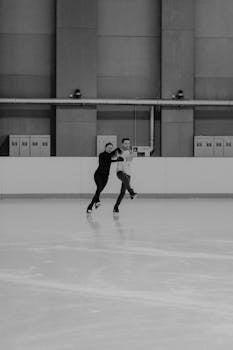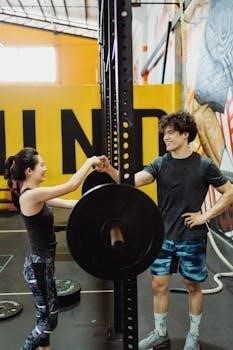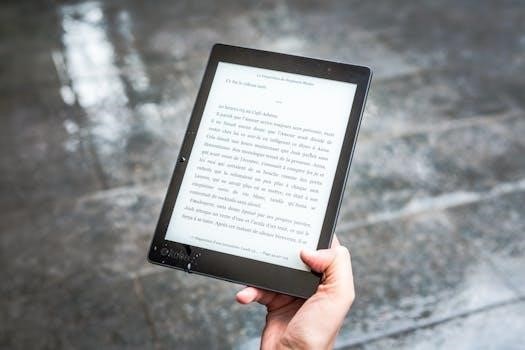de quervain’s tenosynovitis exercises pdf
De Quervain’s tenosynovitis causes pain in the thumb and wrist, and specific exercises can help. These exercises aim to improve movement, strength and function; reducing pain, inflammation and preventing symptom recurrence. Begin slowly, easing off if pain occurs, and progress gradually as tolerated.
Understanding De Quervain’s Tenosynovitis
De Quervain’s tenosynovitis is a painful condition affecting the tendons on the thumb side of the wrist. It involves inflammation of the tendon sheaths that surround the abductor pollicis longus and extensor pollicis brevis tendons. This inflammation causes friction and pain when moving the thumb and wrist. Repetitive thumb and/or wrist movements are a common cause of this condition. Forceful hand movements and activities that increase pain should be avoided. Understanding the underlying cause of this condition is crucial for effective rehabilitation. Specific instructions may include avoiding flexing the thumb and moving the hand toward the pinkie finger. This condition can impact hand function significantly, making daily activities difficult. Treatment focuses on reducing pain and inflammation, restoring normal range of motion, and strengthening the affected area. It is essential to start exercises slowly and with controlled movements to achieve the best results.

Initial Rehabilitation Phase
The initial phase focuses on pain management and reducing inflammation. This often involves isometric exercises, which help to activate muscles without moving the joint. Start these gently several times a day.
Isometric Exercises for Pain Management
Isometric exercises are crucial in the early stages of rehabilitation for De Quervain’s tenosynovitis. These exercises involve contracting your muscles without moving your wrist or thumb, helping to maintain muscle strength and reduce pain. Start by placing your hand palm up on a table, gently resist upward movement of hand using the other hand, hold for about 10 seconds and relax. Focus on controlled contractions, avoiding any movements that increase discomfort. This approach minimizes stress on the affected tendons while promoting blood flow and muscle activation, which can help to reduce inflammation and speed up the healing process. Repeat these exercises a few times per session, a few times per day and gradually increase reps as you feel comfortable. Always prioritize gentle, pain-free movements during this initial stage.

Stretching Exercises
Stretching exercises are important to regain range of motion and flexibility. These should be done after the initial pain subsides. Focus on slow, controlled movements to avoid further irritation.
Opposition Stretch for Thumb Flexibility
The opposition stretch is a key exercise for enhancing thumb flexibility, often recommended in the rehabilitation process. To perform this stretch, begin by placing your hand on a flat surface, ensuring your palm is facing upwards. Gently touch the tip of your thumb to the tip of your little finger, forming an ‘O’ shape with your hand. Maintain this position for approximately six seconds. This action targets the tendons around the thumb, helping to increase their range of motion. Repeat this exercise about ten times per session; It is important to perform the movement slowly and smoothly. This stretch is beneficial in reducing stiffness and improving the overall flexibility of the thumb area. Remember consistency is important; so regular practice of this opposition stretch will aid in reducing symptoms and improving hand function.
Wrist Stretch for Increased Range of Motion
The wrist stretch is crucial for enhancing the range of motion in the wrist, which is often limited by De Quervain’s tenosynovitis. To perform this exercise, start by extending your arm straight out in front of you with your palm facing down. Then, using your other hand, gently pull your fingers towards your body, feeling a stretch along the inside of your wrist. Hold this position for about 15 to 30 seconds. It’s important to avoid any sudden or jerky movements. This stretch helps to alleviate tension in the tendons and muscles of the wrist. Slowly release and repeat the stretch several times. Consistent practice of this wrist stretch can significantly improve wrist flexibility and reduce stiffness, making it an important part of any rehabilitation program. This exercise should be performed gently;

Strengthening Exercises
Strengthening exercises are important for De Quervain’s tenosynovitis rehabilitation, helping to speed up healing and reduce symptoms. These exercises should be done when the initial pain has subsided, focusing on building strength in the thumb and wrist.
Thumb Flexion with Resistance
Thumb flexion with resistance is a strengthening exercise beneficial for individuals recovering from De Quervain’s tenosynovitis. This exercise aims to enhance the strength of the muscles responsible for thumb movement. To perform this exercise, secure a rubber band around your thumb, holding the other end with your other hand. Gently flex your thumb, resisting the pull of the band. Ensure the movement is controlled, avoiding any sudden jerks. Focus on the muscles working during the flexion. This exercise should be performed when the initial pain has subsided, and it’s important to listen to your body and stop if you experience any pain. This will help improve the stability and strength of the thumb. This exercise can be repeated multiple times per session, slowly increasing the number of repetitions as strength improves.
Wrist Radial Deviation Strengthening
Wrist radial deviation strengthening is a key exercise in the rehabilitation process for De Quervain’s tenosynovitis. This exercise focuses on strengthening the muscles responsible for moving the wrist towards the thumb side; It is crucial to perform this exercise with controlled movement and without causing pain. You can use a light weight or resistance band to provide resistance. Slowly move your wrist towards the thumb side, and then return to the neutral position. During this exercise, ensure you are not overexerting the muscles. If you feel any pain, stop the exercise and rest. Consistent practice of this strengthening exercise will help improve the stability and function of the wrist and thumb, essential for various everyday tasks. This exercise can be gradually progressed by increasing resistance or repetitions.

Advanced Exercises and Considerations
Mobilisation with movement can decrease pain and improve range of motion, and function. Progression should be gradual, avoiding forceful movements, and any activities that increase pain. Pay attention to any symptoms.
Mobilisation with Movement
Mobilisation with movement is a technique that has shown effectiveness in decreasing pain, improving range of motion, and enhancing the overall function of a patient dealing with De Quervain’s tenosynovitis. This approach involves performing specific movements while simultaneously applying a gentle, supportive force to the affected area. The combined action aims to restore normal joint mechanics and reduce strain on the tendons. It is important to note that this should be done in a controlled manner. This technique should be performed with guidance from a qualified professional. The goal is to facilitate smoother tendon gliding and alleviate discomfort during movement. Always ensure movements are pain-free and that you are not over-exerting the affected area.
Progression and Precautions
As you progress with De Quervain’s tenosynovitis exercises, it’s crucial to listen to your body and increase intensity gradually. Start with the isometric exercises, performing them several times a day. Gradually build up the repetitions and sets as your symptoms allow. If you experience any pain during an exercise, stop immediately and reduce the intensity or take a break. Avoid repetitive movements of the thumb and wrist. It’s also important to avoid forceful hand movements, and movements that increase your pain. Remember to maintain controlled movements to get the best results, and always be aware of your body’s signals. If symptoms persist it may be appropriate to seek medical advice.


